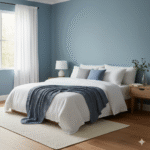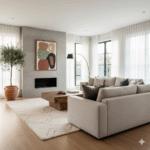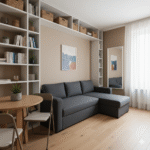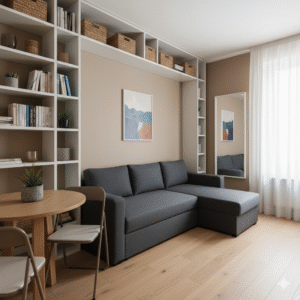Small Space, Big Style. Interior Design Tips for Compact Homes
Introduction
Designing small spaces is all about creativity and smart choices. With the right strategies, even the most compact homes can feel open, stylish, and highly functional. These ideas prove conclusively that size doesn’t limit sophistication—it simply forces you to be more imaginative.1. Master the Multi-Functional Furniture
In a small home, every piece of furniture must earn its spot, ideally by serving more than one purpose. Think beyond simple pieces and invest in multi-functional items. Examples include a sleek sofa bed that transitions seamlessly for overnight guests, ottomans with removable lids for hidden storage, or a dining table that folds down or doubles as a spacious workspace when not in use. This strategy maximizes utility without cluttering your precious floor area.2. Harness the Power of Light and Mirrors
Natural light is your best visual trick, as it instantly expands a room. Maximize it by using sheer or light-colored curtains instead of heavy drapes. To amplify this effect, use reflective surfaces and strategically placed mirrors. A large, well-positioned mirror can not only reflect light but also create the illusion of an extra window or doorway, making the room appear significantly larger than it is.3. Embrace Vertical Storage
When floor space is at a premium, the only way to go is up. Vertical storage is essential for keeping things organized without tripping over them. Install tall, custom shelving units that reach all the way to the ceiling, utilize wall-mounted cabinets, or use hanging organizers in closets and pantries. By maximizing the wall space, you keep the floor clear and the room feeling airy.4. Build a Neutral Base with Bold Accents
To maintain a spacious feel, keep the main elements—walls and large furniture pieces like the sofa—in a neutral color palette (whites, grays, or soft taupes). This calm backdrop prevents the space from feeling visually chaotic. You can then inject your personality and pops of color using bold accents through smaller, easily changeable items like throw pillows, vibrant rugs, or striking pieces of artwork. This approach creates depth without overwhelming the compact area.5. Be Ruthless About Clutter
More than anything else, clutter shrinks a room faster than its actual square footage. For a small space to work, you must adopt a minimalist mindset. Keep accessories to a minimum and prioritize items that are both beautiful and genuinely useful. Remember: less is truly more when you’re maximizing a small footprint.6. Design Smart Layouts to Define Zones
Even in a studio apartment or open-concept room, you need to define areas for living, sleeping, and dining. Use furniture placement to create subtle divisions. For instance, use the back of a small sectional or a carefully placed area rug beneath a dining table to visually separate the kitchen area from the living room, ensuring each ‘zone’ has a clear purpose.7. Invest in Statement Pieces
You don’t need many things to make a statement, just one right thing. One standout item, such as an oversized abstract artwork, a unique designer armchair, or a distinctive light fixture, gives your small space character and focus without the visual noise of many tiny objects. It elevates the entire room instantly.Conclusion
Compact homes don’t need to compromise on style or comfort. By focusing on multi-functional furniture, clever layouts, and the right balance of light and color, you can design small spaces that feel expansive, personal, and utterly beautiful.- The Psychology of Colors in Interior Design - Copy

- 7 Timeless Interior Design Trends That Will Never Go Out of Style - Copy

- Small Space, Big Style. Interior Design Tips for Compact Homes - Copy

- Small Space, Big Style. Interior Design Tips for Compact Homes - Copy

- 7 Timeless Interior Design Trends That Will Never Go Out of Style - Copy

Categories
Dana Nassour
Dana Nassour is a designer who finds beauty in the everyday and translates it into thoughtful, well-crafted spaces. With a deep appreciation for detail and the emotional impact of design, her work focuses on how environments make people feel. Dana brings creativity and sensitivity to every project, ensuring that each space is not only functional but also meaningful and timeless.




